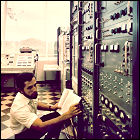 Cornell University student Richard Lovelace, working at the Cornell-funded Arecibo Radio Telescope in Puerto Rico, uses the massive telescope and its on-site computers to determine the rotational period of a pulsar discovered near the center of the Crab Nebula, approximately 6,500 light years from Earth. The position of the pulsar relative to the nebula strengthens the case for pulsars and (still hypothetical) neutron stars occurring at the heart of supernova remnants. The Crab Nebula pulsar had been discovered only three years earlier.
Cornell University student Richard Lovelace, working at the Cornell-funded Arecibo Radio Telescope in Puerto Rico, uses the massive telescope and its on-site computers to determine the rotational period of a pulsar discovered near the center of the Crab Nebula, approximately 6,500 light years from Earth. The position of the pulsar relative to the nebula strengthens the case for pulsars and (still hypothetical) neutron stars occurring at the heart of supernova remnants. The Crab Nebula pulsar had been discovered only three years earlier.
Tags:
Categories
Comments are closed